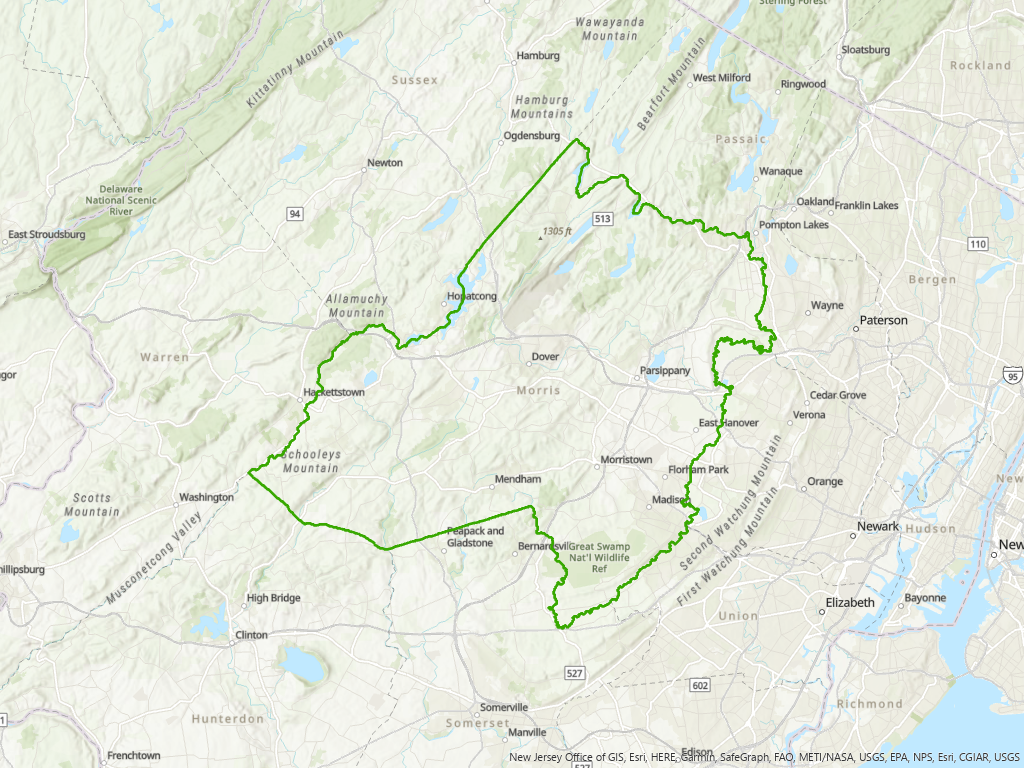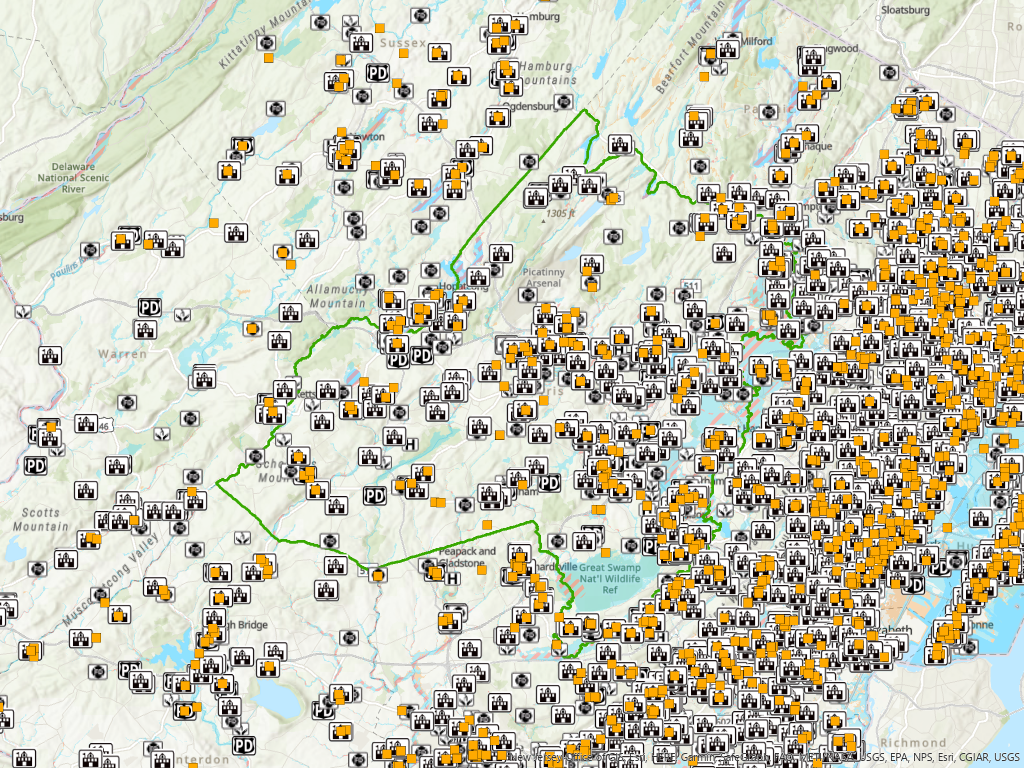Morris County: Critical Assets Exposure Snapshot
Introduction
Data Last Updated: 2023-09-18 12:54:31
 Critical assets are places a community needs to provide education, care, and public safety to residents.
Some critical assets may be in areas that flood now, or are expected to flood in the future.
It is important to understand critical assets’ exposures to flood events, along with exposures to roads leading to and from those facilities.
Knowing the services provided by critical assets will help a community plan for flooding.
Critical assets are places a community needs to provide education, care, and public safety to residents.
Some critical assets may be in areas that flood now, or are expected to flood in the future.
It is important to understand critical assets’ exposures to flood events, along with exposures to roads leading to and from those facilities.
Knowing the services provided by critical assets will help a community plan for flooding.
There are 3 types of flood events:
- Riverine (or ‘fluvial’) flood events occur when intense rain events cause rivers and streams to overtop their banks.
- Flash (or ‘pluvial’) floods occur when intense rainfall causes a flood event that is not directly associated with a body of water. For example, flash flood events include floods in roadways from impaired stormwater management systems.
- Coastal flood events occur when sea-level rise, high tides, and storm surge combine to create flood events that range from nuisance high-tide floods to destructive storm tides from seawater.
The Federal Emergency Management Agency (FEMA) models flood hazards, both riverine (1) and coastal (3), as part of the National Flood Insurance Program (NFIP) regulations and insurance requirements. FEMA does not model flash flood events (2) for their NFIP flood mapping.
Morris County: Critical Assets Exposure Snapshot
Critical Assets in FEMA Flood Zone Areas
| Total Assets | # Exposed in ... | |||
|---|---|---|---|---|
| Assets | 1% Annual Chance Flood | 0.2% Annual Chance Flood | Regulatory Floodway | |
| Schools | 171 | 0 | 2 | 0 |
| Fire Stations | 92 | 6 | 9 | 1 |
| Hospitals | 11 | 1 | 1 | 0 |
| Law Enforcement | 41 | 3 | 3 | 1 |
| Nursing Homes / Assisted Care | 11 | 1 | 1 | 0 |
| Child Care Facilities | 243 | 10 | 16 | 0 |
| Evacuation Shelters | 144 | 4 | 7 | 2 |
The FEMA National Flood Hazard Layer (NFHL) dataset represents the current effective flood data across the United States. Areas in the National Flood Hazard Layer are:
- Floodway: The floodway is the channel of a stream plus any adjacent floodplain areas that must be kept free of encroachment so that the 1% annual chance flood can be carried without substantial increases in flood height.
- 1% Annual Chance Flood: The 1% annual flood (100-year flood), also known as the base flood, is the flood that has a 1% chance of being equaled or exceeded in any given year. The Special Flood Hazard Area is the area subject to flooding by the 1% annual chance flood. Areas of Special Flood Hazard include Zones A, AE, AH, AO, AR, A99, V, and VE. The Base Flood Elevation is that water-surface elevation of the 1% annual chance flood.
- 0.2% Annual Chance Flood: The 0.2% annual flood (500-year flood) is the flood that has a 0.2% chance of being equaled or exceeded in any given year.
- Areas of Undetermined Flood Hazard are areas with possible but undetermined flood hazards.
- FEMA Flood Zone exposure analyses are inclusive of lesser FEMA flood designations. The number exposed to 1% Annual Chance Flood includes those exposed in the Regulatory Floodway area in its analysis and the 0.2% Annual Chance Flood includes those exposed in the 1% Annual Change Flood and in the Regulatory Floodway.
Morris County: Critical Assets Exposure Snapshot
Morris County: Critical Assets Exposure Snapshot
Legend
NJ Political Boundaries
FEMA NSS - Shelter Locations
FEMA Flood Zones
Flood Hazard Areas
Public schools
Fire Stations
Hospitals
Local Law Enforcement Locations
Nursing Homes
Child Care Centers
Metadata / Sources - Flood Hazards
| Where to Get It | |||
|---|---|---|---|
| Name | Description | Map Service | Authoritative Source |
| FEMA Flood Zones | This FIRM data service allows users to view FIRMs for NJ. Counties were combined using the data downloaded from FEMA's Region II office. | FEMA Flood Zones Map Service | Federal Emergency Management Agency(FEMA) |
Metadata / Sources - Facilities
| Where to Get It | |||
|---|---|---|---|
| Name | Description | Map Service | Authoritative Source |
| Public Schools | This Public Schools feature dataset is composed of all Public elementary and secondary education facilities in the United States as defined by the Common Core of Data (CCD, https://nces.ed.gov/ccd/), National Center for Education Statistics (NCES, https://nces.ed.gov), US Department of Education for the 2015-2016 school year. This includes all Kindergarten through 12th grade schools as tracked by the Common Core of Data. Included in this dataset are military schools in US territories and referenced in the city field with an APO or FPO address. DOD schools represented in the NCES data that are outside of the United States or US territories have been omitted. This release includes the addition of 1889 new records, and removal of 1985 records not present in the NCES CCD data. | Public Schools Map Service | Office of Homeland Security - Homeland Infrastructure Foundation-Level Data (HIFLD) Working Group |
| Fire Stations | Fire Stations in the United States Any location where fire fighters are stationed or based out of, or where equipment that such personnel use in carrying out their jobs is stored for ready use. Fire Departments not having a permanent location are included, in which case their location has been depicted at the city/town hall or at the center of their service area if a city/town hall does not exist. This dataset includes those locations primarily engaged in forest or grasslands firefighting, including fire lookout towers if the towers are in current use for fire protection purposes. This dataset includes both private and governmental entities. Firefighting training academies are also included. TGS has made a concerted effort to include all fire stations in the United States and its territories | Fire Stations Map Service | Office of Homeland Security - Homeland Infrastructure Foundation-Level Data (HIFLD) Working Group |
| Hospitals | This feature class/shape file contains locations of Hospitals for 50 US states, Washington D.C., US territories of Puerto Rico, Guam, American Samoa, Northern Mariana Islands, Palau, and Virgin Islands. The dataset only includes hospital facilities based on data acquired from various state departments or federal sources which has been referenced in the SOURCE field. Hospital facilities which do not occur in these sources will be not present in the database. The database does not contain nursing homes or health centers. Hospitals have been categorized into children, chronic disease, critical access, general acute care, long term care, military, psychiatric, rehabilitation, special, and women based on the range of the available values from the various sources after removing similarities. | Hospitals Map Service | Office of Homeland Security - Homeland Infrastructure Foundation-Level Data (HIFLD) Working Group |
| Law Enforcement Facilities | Law Enforcement Locations in the United States, any location where sworn officers of a law enforcement agency are regularly based or stationed. Law Enforcement agencies "are publicly funded and employ at least one full-time or part-time sworn officer with general arrest powers". This is the definition used by the US Department of Justice - Bureau of Justice Statistics (DOJ-BJS) for their Law Enforcement Management and Administrative Statistics (LEMAS) survey. Although LEMAS only includes non-Federal Agencies, this dataset includes locations for federal, state, local, and special jurisdiction law enforcement agencies. Law enforcement agencies include, but are not limited to, municipal police, county sheriffs, state police, school police, park police, railroad police, federal law enforcement agencies, departments within non law enforcement federal agencies charged with law enforcement (e.g., US Postal Inspectors), and cross jurisdictional authorities (e.g., Port Authority Police). | Law Enforcement Facilities Map Service | Office of Homeland Security - Homeland Infrastructure Foundation-Level Data (HIFLD) Working Group |
| Nursing Home/Assisted Care Facilities | The Nursing Home / Assisted Care feature class/shape file contains facilities that house elderly adults. This feature class’s/shape file’s attribution contains physical and demographic information for facilities in the continental United States and some of its territories. The purpose of this feature class/shape file is to provide accurate locations for high concentrations of elderly adults in the event of a disaster. The attribution within this feature class/shape file was populated via open source methodologies of authoritative sources. During the update cycle for this deliverable, there were 6010 records added. | Nursing Home/Assisted Care Facilities Map Service | Office of Homeland Security - Homeland Infrastructure Foundation-Level Data (HIFLD) Working Group |
| Child Care Centers | This data is a graphical representation of the listing of licensed active child care centers in NJ. It was created for the State of New Jersey's initiative regarding child care centers near contaminated sites. As of the April 2017 child care center GIS layer revision, non-profit child care centers found in Public Schools (NIPS) are also included in this GIS layer even though they are not required to submit environmental data to the NJDEP for NJDCF licensing. Proposed child care centers are not listed until a NJDCF License number is issued. | Child Care Centers Map Service | New Jersey Department of Environmental Protection (NJDEP) |
| Evacuation Shelters | The National Shelter System feature class/shape file contains facilities that can house individuals in the event of an issued evacuation for the facilities area. This feature class/shape file’s attribution contains physical, demographic, and capacity information for facilities in the continental United States and some of its territories. The purpose of this feature class/shape file is to provide accurate locations for a potential shelter in the event of a disaster. The facilities included have been designated as a Shelter by either the Federal Emergency Management Agency (FEMA) or the American Red Cross (ARC) | Evacuation Shelter Map Service | Office of Homeland Security - Homeland Infrastructure Foundation-Level Data (HIFLD) Working Group |
| Historic Preservation Properties | Historic Properties are buildings, sites, structures or objects that are evaluated as historically significant. This dataset represents the polygon boundaries of historic properties that: 1. Are National Historic Landmarks, 2. Are included in the New Jersey or National Registers of Historic Places, 3. Have been determined Eligible for inclusion in the registers through federal or state processes administered by the HPO, 4. Have been designated as Local Landmarks by local government, or 5. Have been identified through cultural resource survey or other documentation on file at the HPO. | Historic Property Map Service | New Jersey Department of Environmental Protection |
